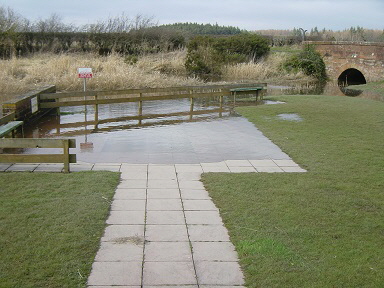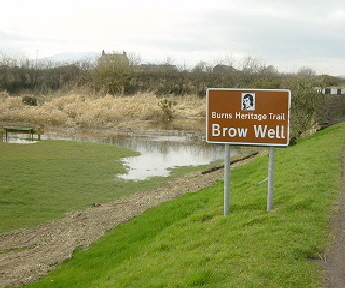|
Brow Well
2009 SSCBA Brow Well ceremony
 
In July 1796 Robert Burns found himself, 0n the advice of his physician Dr. Maxwell at a point where the waters issuing from a spring meets the flow of the spring tides on the salt marshes at the East end of the Solway coast where cattle drovers travelled on route from Dumfries to Carlisle
Each year Burnsians and friends assemble in mid July to hold a service to mark the Bard’s stay at the Brow. Those who have attended over many years are well aware of the vagaries of the weather, ranging from intolerable gale lashed coastline to a fine breeze-less summers evening.
While paying homage they must surely reflect on the ‘cure’ prescribed by Dr. Maxwell, wading, fully clothed, oxter (arm pit) deep in the cold muddy waters of the Solway Firth and allowing bhis clothes to dry on him.
He also had to drink the iron stained (chalybeate) waters of the well using an iron cup which was attached to the side of the well.
One can imagine the discomfort he must have experienced while in the last stages of emaciation and feebleness.
A small respite from this condition would have been experienced while visiting the Inn at Clarencefield and obtaining a bottle of port, the cost of which he had to bargain with the landlord by offering a seal pendant off his watch chain. However on being recognised by the landlord’s wife, who said “ Man, do ye no’ ken that this is Scotland’s Bard” - the bottle was handed over without payment
Whilst at the Brow he had his last meeting with Maria Riddell, who her self was recovering from illness and also partaking the mineral waters. He greeted her with the words – “ Well Madam have you any commands for the other world”. Her impression of Burns recorded that his features displayed the stamp of death. In her encourage to him she hoped that he would survive herself and write her epitaph.
Burns also enjoyed the sympathetic company of Rev. Henry Duncan, the assistant minister at Ruthwell, who later became the minister of Ruthwell. The Rev. Duncan was founder of the world’s first SavingsBank and was joint secretary of the Burns Mausoleum Committee.
During his stay in the Parish of Ruthwell Burns corresponded with a few of his contemporaries and most were informed of his poor state of health. A letter to Mrs Dunlop also contained a plea for reconciliation with her. She corresponded with Robert’s brother, Gilbert who in his reply stated that the bard was hoping to stay for the summer at the little hamlet. This statement of Gilbert’s added confusion to the situation, since the tides were becoming smaller, scarcely covering the mud banks, making bathing impossible and Burns would have returned to Dumfries in any case.
In feeble condition and the need for the occasional help from his chair, the Bard was seen as a potential threat by the tailor who had made his Volunteer Company uniform and to whom he owed a few pounds. The threat of a dishonourable death made him write to his two friends, James Burgess and George Thomson, to ask for sufficient funds to cover his debt. Both gentlemen responded to the dying poets request – thus helping to dispense the imagined thoughts of impending imprisonment.
Whilst spending one of his last nights at the Brow he drank tea with Mrs Craig, at Ruthwell Manse. Her daughter attempted to draw the curtains to shade the sun from the Bard’s eyes and he restrained her by saying -- Let it shine lass. It’ll no shine long for me noo --
A few days later a request was made to Johns Clark for the use of his gig tom convey Burns back to Dumfries.
Jessie Lewars nursed Burns through most of his, his wife Jean expecting anyday. Jessie’s continual attendance was highly thought of by Burns and the last song he wrote - O wert thou in the cauld blast – was dedicated to her
Jean was soon to be a widow and her husband enshrined for ever in the hearts of his fellow countrymen.
The Brow Well, once a small hamlet, is now just a few cottages adjacent to a well kept grassed area containing the WELL
The hostelry in which Burns stayed was demolished in 1863 when road widening took place. Although the Inn was rather Spartan, the Davidsons provided as much comfort as they could.
It should be noted that in these early times cattle were driven along well defined routes -- away from the main routes used by coaches and those on foot – and the drovers had to make sure their cattle did not stray and trample over crops or turn the area under foot into a quagmire.
Cattle were driven from port of Portpatrick where cattle from Ireland landed and wended through Castle Douglas, Dumfries ( where cattle were sold in the markets) , along the coast via the Brow to Annan ,Carlisle and onwards to Huntingdon where the cattle were fattened and then taken on to London.
You can see a cast iron plaque on the side of the Midsteeple in the centre of Dumfries and thereon it gives the mileages to Glasgow, Edinburgh, Portpatrick, Huntingdon and others.
This unspoilt part of the coast, some 10 miles South East of Dumfries, can be reached by following the B725 route between Clarencefield and Bankend.
|